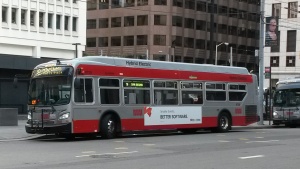Bus
Buses are a staple in public transportation in America. Buses operate on most major streets in every metropolitan area. Buses are relatively inexpensive to operate and require little additional infrastructure beyond roads that already exist.
Buses typically operate on a schedule and along a specified route. Some service may permit pick up and drop offs outside the route (see below). See dial-a-ride or microtransit for service that provide door to door pick ups.
Contents
Types of bus service
Local bus
Most cities have publicly provided scheduled, fixed-route local bus service. These routes have stops about every 1/4 mile apart at or near street intersections. Local routes provide basic community service and destinations generally include schools, hospitals, shopping center, and downtowns.
Service levels on local routes vary. Service can be as frequent as a few minutes throughout the day on major streets in big cities such as San Francisco or Seattle. 30 minute is a common service frequency for suburbs. Some routes operate only during peak or school hours.
Many cities have a local bus network that form a grid (a series of routes running north-south and others running east-west, along the arterial streets 1/2 a mile or a mile apart). The grid system allows riders to access most part of the region with a single transfer.
Limited-stop or rapid bus
These routes provide skip-stop service on corridors that also have frequent local service and are intended to provide faster service for longer distance riders. Stops are located about 1/2 mile to a mile apart. These routes may provide all day service or just during the peak hours when ridership is high.
Some rapid bus routes have dedicated infrastructures such as bus lanes and policies like all-door boarding. These elements are a part of bus rapid transit.
Express bus
Express routes provide long distance service that also operate non-stop on highways. Many of those routes are of commuter nature - operate only during peak hours picking up from the suburbs and dropping off in downtown. Other express routes provide all-day, 7-day a week connection between cities, and between cities with rail or ferry. Express routes generally charge higher fares.
Some express bus routes have dedicated infrastructures such as high occupancy lanes and in-freeway bus stops. These elements are a part of bus rapid transit.
Shuttle bus
These routes generally provide short distance service intended to fill gaps: such as between a college and a rail stop that is a mile away. Shuttles may be operated by the destination entity (college, hospital, employer) rather than the area's public transportation agency.
Flex route
Some local and shuttle bus routes may permit door to door pick ups and drop offs within a specific area (either a neighborhood or some distance outside of the route). Pick ups can be arranged on-call. Some routes allow door to door pick ups to be scheduled by any passenger, while some others are restricted to those with limited mobility. Passengers can still board the bus at regular stops without reservation.
Intercity bus
Intercity buses provide long distance service between major metropolitan areas, or between major cities and rural communities. Many of the intercity bus service is operated by private companies on a for-profit basis. Intercity buses typically pick up at one location within the city, and tickets for the service can be purchased ahead of the trip.


